rotten > Library > Crime > Terrorism > September 11
September 11, 2001
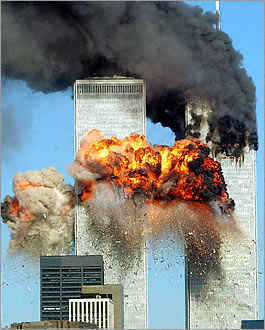 When you look at the minute-by-minute account of what happened on September 11, a few things become clear.
When you look at the minute-by-minute account of what happened on September 11, a few things become clear.
One inescapable conclusion is that most agencies of the U.S. government suffered a near-total failure to perform their stated functions.
It's debatable whether the government could have actually lessened or prevented any deaths by doing its job that day. What is painfully clear, however, is that just about everyone who could drop the ball did drop the ball.
Nothing functioned the way it was supposed to, and America was leaderless in most meaningful senses for the entire duration of the most stunning homeland attack in history.
Eventually, a leader finally did emerge, a forceful figure giving orders and making the tough calls from the nerve center of the American government. Unfortunately, that leader did not happen to be the constitutionally elected President of the United States.
The following minute-by-minute chronology is not filled with controversial half-truths. All of the facts below are firmly established, with only two serious exceptions, both of which are specifically highlighted in the text.
The main body of the story is largely drawn from numerous staff reports by the 9/11 Commission, which are by far the primary source. A handful of juicy details were drawn from "A Pretext for War: 9/11, Iraq, and the Abuse of America's Intelligence Agencies" by James Bamford and "Against All Enemies" by Richard A. Clarke. A few additional details came from timelines published by the New York Times, the Washington Post and CNN, as well as official White House records of the day.
The tale that unfolds here is long and painful, but important. Those who do not learn from history are condemned to repeat it. The list of mistakes made on September 11, 2001, is daunting. But we can't afford to repeat them.
When Ignorance Is Understandable
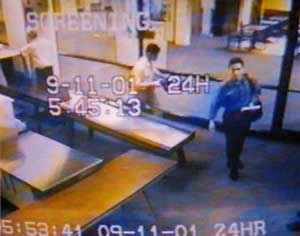 During the first phase of the attack, it took a few minutes to figure out what was happening. That isn't surprising. But while air traffic controllers on the front lines quickly figured out the significance of what they were hearing, the FAA and other managers failed to treat this information with the urgency and speed it demanded.
During the first phase of the attack, it took a few minutes to figure out what was happening. That isn't surprising. But while air traffic controllers on the front lines quickly figured out the significance of what they were hearing, the FAA and other managers failed to treat this information with the urgency and speed it demanded.
The result? While ground-level workers in every branch of government did their best to address the situation, key middle managers sat frozen in indecision and effectively stopped the movement of vital information both up and down the chain of command.
| 5:33a | Mohammed Atta and another hijacker enter the security gate in Portland, Maine, for a flight to Logan Airport in Boston. |
| 5:45a | Mohammed Atta successfully passes security. |
| 7:18 | Hijackers pass through security at Dulles Airport in Washington, D.C. |
| 7:59 | American Airlines Flight 11 lifts off from Logan Airport in Boston and went into the air. |
| 8:13 | A routine acknowledgement is the last communication received from the crew of AA 11. |
| 8:13 | Mohammed Atta and four other passengers storm the cockpit using plastic knives and box cutters. They stab two first-class flight attendants. |
| 8:14 | American 11 ignores an air traffic controller's order to climb to 35,000 feet. |
| 8:14 | United Airlines Flight 175 takes off from Logan Airport in Boston. |
| 8:16 | American Airlines Flight 77 taxis onto Dulles airport runway. |
| 8:21 | American 11 turns off its transponder, disabling the major mechanism for tracking the flight from the group. Air traffic controller tells his supervisor something is wrong. |
| 8:23 | American 11 changes route. |
| 8:24 | On American 11, Mohammed Atta accidentally depresses the "talk" button the radio while trying to address passengers on the intercom, broadcasting the message: "We have some planes. Just stay quiet, and you'll be O.K. We are returning to the airport." |
| 8:25 | Atta radios: "Nobody move. Everything will be O.K. If you try to make any moves, you'll endanger yourself and the airplane. Just stay quiet." Air traffic control realizes the flight has been hijacked. |
| 8:28 | Boston air traffic controllers inform FAA Command Center in Herndon, Va., that American 11 has been hijacked and is headed toward New York City airspace. |
| 8:32 | FAA Command Center informs FAA headquarters (inexplicably not the same thing) that American 11 may have been hijacked. FAA is supposed to call in the military. It doesn't. |
When Ignorance Is Not Understandable
Once the formal notice of a hijacking reached Washington, D.C., you would expect the well-oiled mechanisms of national security to snap into place with lightning-like speed. Unfortunately, nothing of the sort happened. Instead, the FAA acted as a lethal information sink, taking calls from around the country but failing to pass the information along. NORAD was not much better. Although fighters were dispatched quickly, they weren't given any orders, which rendered them pointless.
While NORAD did send orders DOWN the chain of command, virtually no information about what was happening traveled UP the chain of command. Between NORAD and the FAA, middle managers and bureaucrats were making ALL the decisions about how to handle what was quickly evolving into a wartime crisis.
Meanwhile, a full half-hour into the crisis, the White House and the nation's top intelligence officials were getting ALL of their information from television news, and even that information was not being distributed efficiently.
So the president of the United States shrugged off a full-scale assault on his country in favor of listening to elementary school students read, while the director of the CIA ate breakfast, the acting commander of the combined armed forces schmoozed with a congressman for 45 minutes, the director of the NSA conducted a routine staff meeting and the vice president only found out what was going on when he plopped down in front of a TV.
| 8:34 | Mohammed Atta: "Nobody move please. We are going back to the airport. Don't try to make any stupid moves." |
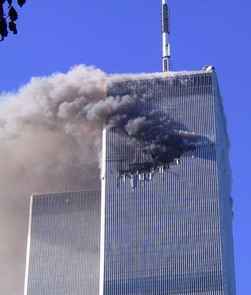 |
| 8:34 | Boston controllers take it on themselves to call the military. |
| 8:37 | United Airlines Flight 175 tells Boston controllers that it saw American 11 fly past. |
| 8:38 | Boston controllers reach the Northeast Air Defense Sector of NORAD. NORAD is conducting a security training exercise at the time, and the call is initially believed to be part of the drill. |
| 8:40 | Someone at the FAA thinks to call Northeast Air Defense Sector of NORAD. The following exchange takes place:
FAA: Hi. Boston Center TMU, we have a problem here. We have a hijacked aircraft headed towards New York, and we need you guys to, we need someone to scramble some F-16s or something up there, help us out.
NORAD: Is this real-world or exercise?
FAA: No, this is not an exercise, not a test.
|
| 8:42 | United 175 enters New York City airspace. The air traffic controller assigned to the flight is the same guy tracking American 11. He has other things to think about. |
| 8:42 | United Flight 93 takes off from Newark, more than 40 minutes after its scheduled departure. |
| 8:46 | NORAD orders two F-15s to scramble. |
| 8:46 | Twenty minutes after Atta's voice was first heard announcing the hijacking, no one in the White House or with the President knows that American 11 was hijacked nor do they know that fighter jets are scrambling. |
| 8:46 | American 11 slams into Tower 1 of the World Trade Center and is gone. |
| 8:47 | Someone on United 175 screws up the flight's transponder settings. |
| 8:47 | New York police department declares its second highest level of emergency. |
| 8:48 | CNN breaks in to announce "We have unconfirmed reports this morning that a plane has crashed into one of the towers of the World Trade Center." |
| 8:48 | New York air traffic controllers still unaware that American 11 has crashed into the WTC. |
| 8:48 | Bush spokesman Ari Fleischer gets a call informing him that a plane has crashed into the WTC. |
| 8:50 | The 9-1-1 system of New York City is almost instantly overloaded. |
| 8:51 | New York air traffic controllers realize United 175's transponder code is screwed up. | 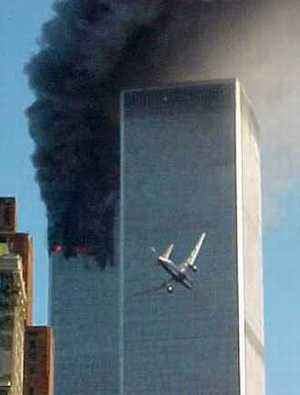 |
| 8:52 | Four companies of NYC firemen arrive at WTC Tower 1. |
| 8:52 | Two F-15s lift off from Otis Air Base in Massachusetts, but they don't know where they're going once they get into the air. |
| 8:52 | New York air traffic controllers hail United 175 and get no response. |
| ~8:53 | George W Bush is informed than an airplane has crashed into the WTC. |
| 8:54 | American 77 breaks from its flight path. |
| 8:55 | New York controllers realize United 175 has been hijacked. |
| 8:55 | Condoleezza Rice tells Bush that the plane which hit the WTC was a twin-engine commercial jet. |
| 8:56 | NY controllers try to inform their managers that another plane has been hijacked, but they're in a meeting to talk about the first one and refuse to take the call. |
| 8:56 | American 77 turns off its transponder. Air traffic controllers in Indianapolis realize they've lost track of the flight. The controllers are not, however, aware that any airplanes have been hijacked this fine morning. |
| 8:58 | New York police department declares the highest possible level of emergency, sending hundreds more police officers to the scene. |
| 8:59 | Fire chiefs decide to evacuate WTC Tower 1. |
| 9:00 | CIA Director George Tenet enjoys a leisurely breakfast with former Senator David Boren at the St. Regis Hotel in Washington, D.C. |
| 9:00 | Acting Chairman of the Joint Chiefs of Staff Richard Meyers enters a self-promoting meeting with Sen. Max Cleland in Washington, D.C. He remains in the meeting for 45 minutes, oblivious to the attack unfolding in America, according to James Bamford. |
| 9:00 | At this moment, there are more than 4,200 airplanes in flight over U.S. airspace. |
| 9:00 | Port Authority police order evacuation of the entire WTC complex. |
| 9:01 | An assistant tells Dick Cheney to turn on his television. |
| 9:01 | NY air traffic controller tells FAA command center: "We have several situations going on here. It's escalating big, big time. We need to get the military involved with us... We're, we're involved with something else, we have other aircraft that may have a similar situation going on here..." This is what passes for notification to the FAA that United 175 has been hijacked. |
| 9:02 | Barbara Olsen, a passenger on Flight 77, calls her husband Theodore Olsen, a top official in the Justice Department, and tells him the flight has been hijacked. |
| 9:03 | United 175 crashes into Tower Two of the World Trade Center. |
| 9:03 | Exactly too late to do anything about it, NORAD is informed that a second plane has been hijacked. | 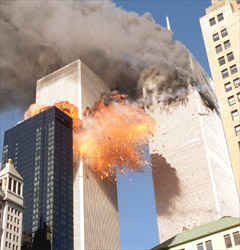 |
| 9:03 | Before beginning a photo-op with elementary school students in Florida, George W. Bush says that he saw "an airplane hit the tower" on TV. |
| 9:04 | Having seen the second plane crash on TV, Cheney and aides in the White House suddenly realize through the power of deductive reasoning that the first crash wasn't an accident... despite having received no information through official channels a full 40 minutes after Mohammed Atta first announced on an open mike that American 11 had been hijacked. |
| 9:04 | Using the power of deductive reasoning, Bush determines he should go hang out with the elementary school students. Bush later claims the crash he saw on TV one minute earlier was the FIRST plane, but the video of the first crash did not air until much later in the day. |
| 9:04 | Using the power of deductive reasoning, Boston air traffic controllers decide to ground all scheduled takeoffs from this point forward. |
| 9:04 | Around this time, Lt. General Michael Hayden, chief of the National Security Agency, learns of the attacks. The leader of America's early warning intelligence system gets the information from an aide who saw it on CNN, according to Bamford. |
| 9:04 | Bush enters the elementary school classroom to expound on the joys of reading. |
When Ignorance Is 'Projecting Calm'
While Bush was captivated by elementary school reading lessons, Dick Cheney was sitting in front of his TV preparing a series of orders which would not actually reach anyone capable of carrying them out.
| 9:05 | Boston tells FAA Command Center that Atta's broadcast said the hijackers had "planes. Plural." | 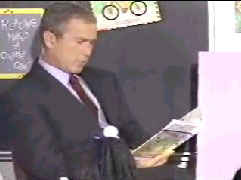
| | 9:05 | New York controllers ground all scheduled takeoffs and landings, and ban all commercial aircraft from entering central New York airspace. |
| 9:06 | White House Chief of Staff Andrew Card whispers into the President's ear: "A second plane hit the second tower. America is under attack." Bush told the 9/11 commission "his instinct was to project calm, not to have the country see an excited reaction at a moment of crisis." You can watch the unedited video of the president "projecting calm." (Link to video) The clip starts with Card's whisper and runs five minutes. Discuss amongst yourselves. |
| 9:06-9:10 | Boston controllers ordered to inform all pilots in the air to heighten cockpit security. Boston suggests to the FAA that this instruction be given nationwide, but the FAA simply ignores this very good suggestion. |
| 9:10 | Around this time, the head of the National Security Agency—the primary early-warning intelligence service for the U.S.—learns that a second airplane has hit the World Trade Centers and that America is under attack... not from a fancy satellite monitor, or a secure COM-SIG-INT intercept, but from watching CNN. |
| 9:07-9:12 | George W. Bush sits quietly in that Florida classroom listening to the children demonstrate reading aloud for five full minutes after being officially informed that America is under attack. "Woo! These are great readers! Very impressive!" are the first words he speaks after being informed of the attack. |
| 9:08 | NORAD learns that the second plane has crashed into the WTC. The commander on duty says "We need to talk to FAA. We need to tell 'em if this stuff is gonna keep on going, we need to take those fighters, put 'em over Manhattan. That's best thing, that's the best play right now. So coordinate with the FAA. Tell 'em if there's more out there, which we don't know, let's get 'em over Manhattan. At least we got some kind of play." | 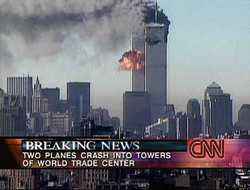 |
| 9:08-9:13 | Despite the grand intentions in the preceding quote, the F-15s spend the next several minutes circling off of Long Island, not receiving any orders to actually do anything. |
| 9:08 | Indianapolis air traffic controllers contact Air Force Search and Rescue at Langley Air Force Base, Virginia, to report American 77 as having crashed (their best guess as to what had happened). |
| 9:09 | Indianapolis controllers report the missing American 77 to the FAA regional center. |
| 9:15 | While leaderless Air Force pilots continue to fly around pointlessly, Bush FINALLY gets out of his chair and works his way to the door. There are conflicting accounts about how long this takes. In an adjoining room, he is briefed by his staff, which is getting its information off the TV. Bush decides to return to Washington. (More on this decision below.) |
| 9:17 | FAA shuts down all New York City airports. |
| 9:20 | Indianapolis controllers learn that other planes have been hijacked. They wonder if they might have missed something here. |
| 9:20 | FAA initiates a cross-agency teleconference on the hijackings. |
| 9:21 | Port Authority closes all bridges and tunnels in the New York area. |
| 9:21 | The following exchange takes place between the FAA and NORAD, referring to American Flight 11 which crashed into the WTC more than half an hour earlier.
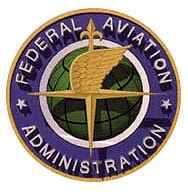
FAA: Military, Boston Center. I just had a report that American 11 is still in the air, and it's on its way towards—heading towards Washington.
NORAD: Okay. American 11 is still in the air?
FAA: Yes.
NORAD: On its way towards Washington?
FAA: That was another—it was evidently another aircraft that hit the tower. That's the latest report we have.
|
| 9:23 | NORAD scrambles fighters from Langley Air Force Base to Washington on a mission to shoot down American 11. Which is, as previously noted, has already crashed into the World Trade Center. |
| 9:25 | Regional FAA officials tell FAA headquarters about the missing American 77, fully sixteen minutes after they first got the call from Indianapolis. |
'Everybody Just Left The Room'
At this point, the only agency with any information that didn't come off of a television set was the FAA, but the FAA was MIA. Despite repeated requests from NORAD, FAA leaders were not available to brief the White House or the military on exactly what the hell was going on, specifically the crucial issue of which airplanes were accounted for and which were not.
Bear in mind that there are still more than 4,000 planes in the air. Only two of these will end up being hijacked. Having an Air Force doesn't count for much when the pilots don't know what to shoot at.
| 9:25 | The FAA Command Center in Herndon orders all aircraft in the country grounded, while FAA headquarters executives were still dithering over whether to give the order. |
| 9:28 | Cleveland air traffic controllers have a routine contact with United Flight 93. |
| 9:29 | Around this time, Thomas Burnett, a passenger on Flight 93 calls his wife and says, "The plane has been hijacked. We are in the air. They've already knifed a guy. There is a bomb on board. Call the FBI." |
| 9:29 | "A radio transmission of unintelligible sounds of possible screaming or a struggle from an unknown origin" is heard by Cleveland controllers, followed by someone screaming "Get out of here, get out of here!" |
| 9:30 | FAA, White House and Defense Department each initiate cross-department teleconferences, insuring that dozens of top decision makers are not making decisions but are instead briefing each other on what they don't know, since none of the participants in these conferences has any more information than what's already on TV. Richard Clarke, director of the Counterterrorism Center, also initiates a teleconference to manage aspects of the crisis. |
| 9:30 | Colin Powell, at a meeting in Peru, is informed about the second plane. "Get the plane. We're leaving," he announces. |
| 9:30 | Fighters take off from Langley, as per orders from NORAD. They fly to Baltimore so they can intercept American 11, which is already crashed into the World Trade Center, instead of flying to Virginia, where they might have a chance of intercepting American 77, which is coming in from the West. |
| 9:30 | Outside the school, Bush makes a statement:
Today we've had a national tragedy. Two airplanes have crashed into the World Trade Center in an apparent terrorist attack on our country. I have spoken to the Vice President, to the Governor of New York, to the Director of the FBI, and have ordered that the full resources of the federal government go to help the victims and their families, and to conduct a full-scale investigation to hunt down and to find those folks who committed this act.
Terrorism against our nation will not stand. And now if you would join me in a moment of silence. May God bless the victims, their families, and America. Thank you very much. |
| 9:30 | Around this time, CIA Director Tenet has his breakfast interrupted, a full hour after Mohammed Atta announced his hijacking over an open mike. "I wonder if it has anything to do with this guy taking pilot training," he says on hearing the news. | 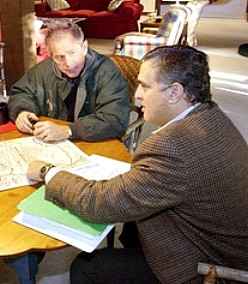 |
| 9:32 | Cleveland controllers hear a broadcast on United 93's frequency: "Ladies and gentlemen, here it's the captain. Please sit down. Keep remaining sitting down. We have a bomb on board." |
| 9:32 | Air traffic controllers at Dulles airport "observed a primary radar target tracking eastbound at a high rate of speed." The FAA notifies the Secret Service. |
| 9:34 | While telling NORAD to watch out for the still-crashed American 11, the FAA mentions to NORAD that American 77 is also missing. This is the very first time NORAD has heard about American 77. |
| 9:34 | FAA headquarters is notified that United 93 has been hijacked. |
| 9:35 | The lobby of WTC Tower 2 is flooded with wounded people attempting to evacuate. |
| 9:35 | Bush's motorcade leaves the Florida school and heads for the Sarasota airport. |
| 9:36 | A different FAA center calls NORAD and informs them that radar is tracking an aircraft speeding toward Washington, and heading toward the White House. |
| 9:36 | When Cleveland air traffic controllers ask if they should inform the military, the FAA Command Center tells them the FAA will handle it. |
| 9:37 | Secret Service agents physically seize Cheney from his desk and carry him down into a bunker underneath the White House. | 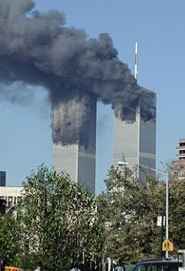 |
| 9:37 | NORAD discovers that the planes it thought were over Baltimore are actually out over the ocean, due to the fact that no one gave the pilots clear orders about where to go. |
| 9:37 | Defense Department starts an "Air Threat" teleconference, which continues for the next eight hours and includes the president and vice president, secretary of Defense Donald Rumsfeld, and all the top military brass. The FAA—the lead federal agency actually DEALING with the crisis—is not included in this conference for the next 40 minutes because it can't get its shit together and get on a secure phone line. |
| 9:38 | A National Guard aircraft, ordered to track the incoming radar bogey, reports that the target is a Boeing 757, and then... "(It) looks like that aircraft crashed into the Pentagon, sir." |
| 9:38 | American 77 crashes into the Pentagon. Rumsfeld is in a teleconference with Richard Clarke when the plane hits, according to Richard Clarke in Against All Enemies. The fact that Rumsfeld was still on camera was the only way Clarke knew the Pentagon hadn't been completely obliterated. |
| 9:39 | United 93 radios Cleveland controllers, yet again proving that the intercom system is the most confusing part of an airplane: "Uh, is the captain. Would like you all to remain seated. There is a bomb on board and are going back to the airport, and to have our demands (unintelligible). Please remain quiet." |
At 9:39, NORAD could not produce an accurate summary of what was going on, despite the fact that news reports clearly proved that two airplanes had crashed into the World Trade Centers. NORAD's latest information was "of a possible hijacked aircraft taking off out of JFK en route to Washington D.C." This was not a reference to United 93, at least not one based on the information they had formally received so far.
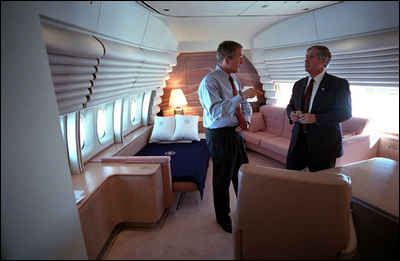
| 9:40 | Donald Rumsfeld reports that smoke is coming into his teleconferencing studio at the Pentagon, and moves to another studio, according to Clarke. Somewhere along the way to his new studio, he take a detour to join the rescue efforts at the Pentagon. Because how else could a Secretary of Defense (a man in his 70s, to boot) be more useful? |
| 9:40 | Some time around now, First Lady Laura Bush is moved to a secure, unmarked location. |
| 9:41 | Hijackers turn off United 93's transponder. |
| 9:41 | Boston air traffic controllers tell NORAD that Delta 1989 might have been hijacked. It wasn't, but NORAD orders fighters to intercept it anyway. It lands without event. |
| 9:41 | Command center established to coordinate emergency response in New York City. |
| 9:42 | Bush's motorcade arrives at the Sarasota, Fla., airport where Air Force One is parked. |
| 9:42 | FAA Command Center learns that the Pentagon has been hit, not from any of the dozens of government sources now working on the emergency, but once again, from the TV. |
| 9:42 | FAA orders all air traffic in the United States to immediately land at the nearest facility. At this moment, that amounts to about 4,500 airplanes. | 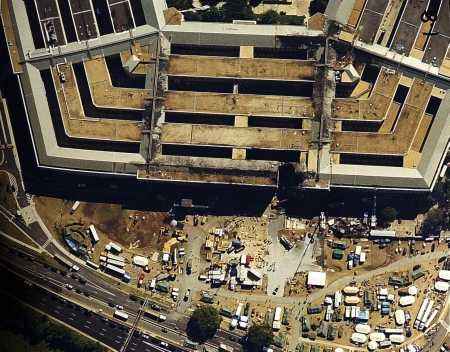 |
| 9:45 | Noticing smoke coming from the Pentagon, members of Congress panic and begin a disorderly evacuation on their own initiative. No one tells them what's going on, or where they should go. |
| 9:45 | Eight minutes after deciding it's too dangerous for Cheney to be in the White House, the Secret Service decides it's too dangerous for everyone else and evacuates the building. |
| 9:45 | The Secret Service decides it's too dangerous for the president to return to Washington. For posterity, the 9/11 commission found that "All witnesses agreed that the President strongly wanted to return to Washington and only grudgingly agreed to go elsewhere." OK, man. Keep your dignity. |
| 9:45 | Bush calls Cheney from Air Force One on the ground. Bush says: "Sounds like we have a minor war going on here, I heard about the Pentagon. We're at war... somebody's going to pay." Cheney urges Bush not to return to Washington. (All witnesses agreed that every cell in Bush's virile, courageous, sweaty body screamed out against this advice and that he yearned instead to throw himself personally into the fray, even volunteering to fly the fighter planes himself.) |
| 9:45 | United 93 passenger Todd Beamer calls a phone company supervisor from the plane. He describes the hijacking and hears about the other attacks. |
| 9:46 | FAA headquarters informed that United 93 is "twenty-nine minutes out of Washington, DC." |
| 9:49 | FAA Command Center speculates that someone at FAA headquarters should really get around to deciding whether to request military assistance. The following exchange takes place, marking what one can only hope will go down in history as the all-time low point in the history of government bureaucracy:
COMMAND CENTER: Uh, do we want to think about, uh, scrambling aircraft?
FAA HEADQUARTERS: Uh, God, I don't know.
COMMAND CENTER: Uh, that's a decision somebody's gonna have to make probably in the next ten minutes.
FAA HEADQUARTERS: Uh, ya know, everybody just left the room. |
| 9:49 | NORAD orders all U.S. military aircraft in the country to battlestations. |
| 9:52 | Fully fifteen minutes after Cheney was taken to the underground shelter to protect him from what was thought to be an imminent risk of death, his wife Lynne is also evacuated from the White House to the bunker. |
| 9:53 | The NSA intercepts a message from an al Qaeda operative in Afghanistan indicating that at least one more target is going to be hit, according to Bamford. |
Shoot To Kill!
With the benefit of hindsight, we know that the crash of United 93 shortly after 10 a.m. was the end of the immediate crisis. At the time, however, no one knew what else could happen. The sky was falling.
Two hours into the attack, there was still no coordinated response from the American government. In fact, as the hours passed, it became agonizingly clear that the U.S. government barely even knew which planes had crashed where.
In fact, the only possible order which could have made a difference—the order to shoot down planes which refused to divert from attack routes—was given 10 minutes after the last hijacked plane had already crashed.
While the order was probably right and sensible, the sad fact is that the horse was long, long gone by the time the barn door was locked.
| 9:53 | First media reports that a plane has hit the Pentagon. | 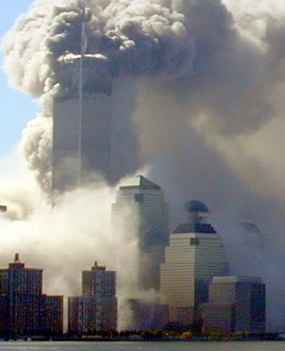 |
| 9:53 | FAA bureaucrats continue to discuss whether to request that fighters intercept United 93. |
| 9:54 | FAA command center loses radar contact with United 93. |
| 9:54 | United 93 passenger Thomas Burnett tells his wife he thinks the hijackers are planning to crash the plane. He tells her, "There's three of us who are going to do something about it." |
| 9:55 | Cheney advises Bush over the phone that three planes were missing and one had hit the Pentagon. |
| 9:55 | Partial evacuation of the Pentagon ordered. |
| 9:55 | Elderly, handicapped and other slower-moving people are still evacuating Towers One and Two of the WTC complex. |
| 9:55 | Air Force One takes off, with no destination recorded at takeoff. |
| 9:58 | United 93 passenger Todd Beamer is heard over an open phone line announcing, "Let's roll," as the passengers began an attempt to take back the cockpit. |
| 9:59 | The Deputy National Security adviser requests could someone, somewhere, please start working on ensuring the continuity of government, that someone produce fighters to escort Air Force One to where ever it's going, and that a fighter combat air patrol be put into place over Washington, DC. |
| 9:59 | Another pilot spots United 93 "waving his wings." |
| 9:59 | Tower One of the World Trade Center collapses in a cloud of dust. |
| 10:00 | At least two companies of firefighters have entered Tower Two and are climbing to assist survivors. |
| 10:00 | Cheney enters White House shelter's conference room. Somewhere around this time, Cheney supposedly calls Bush to ask for authorization to let U.S. fighters shoot down civilian aircraft that refuse to divert away from high-value targets. Supposedly, Bush agrees to this. We all know Cheney would never give such an order without Bush's permission. For the record, however, there is no independent documentation of this conversation. |
| 10:00 | Bush contacts Donald Rumsfeld, who is technically second in the chain of command between Bush and the armed forces. They do not discuss the possibility of shooting down civilian planes, and Bush does not convey any such authorization to Rumsfeld. |
| 10:00 | Passengers of United 93 storm the cockpit in an effort to stop the plane from reaching its intended target, believed to be either the White House or the Capitol. |
| 10:02 | Cheney and others in the White House bunker are informed that a plane is speeding their way. |
| 10:03 | United 93 crashes in western Pennsylvania. |
| 10:07 | The NORAD representative on the Air Threat teleconference announces: "NORAD has no indication of a hijack heading to Washington DC at this time." This statement is technically correct only by virtue of incompetence, since NORAD never knew anything was heading for Washington. |
| 10:07 | Four minutes after it is no longer an issue, NORAD is informed by Cleveland control that United 93 has been hijacked. Luckily for FAA headquarters, it is now an academic point that they FORGOT to call for military assistance to prevent United 93 from crashing into a major government building, as would almost certainly have happened if not for the passengers rising up against the hijackers. |
| 10:07 | Secret Service agents take up positions around the White House, armed with automatic weapons. |
| 10:08 | FAA headquarters informed that United 93 may have crashed. |
| 10:08 | NORAD continues to search for United 93 in the air, because no one has informed them that it may have crashed. |
| 10:10 | NORAD informs fighter pilots they do NOT have "clearance to shoot" aircraft over Washington, D.C. |
| 10:10 | NORAD goes to DEFCON 3 alert status, a level of alert not seen in the United States since the 1983 Matthew Broderick movie "Wargames." |
| 10:11 | A military aide asks Cheney whether fighter pilots can shoot down an "incoming" aircraft (United 93, which has actually been on the ground for 10 minutes). Without batting an eye, Cheney approves the shootdown. Later, he says, "I didn't agonize over it." |
| 10:15 | Air traffic controllers in Washington, D.C. tell NORAD that United 93 is "down." |
| 10:16 | The military aide returns to the White House shelter and again asks Cheney if fighter planes are authorized to shoot down incoming aircraft. Cheney authorizes the shootdown a second time. |
| 10:17 | A civilian aide suggests that Cheney might want to check in with the president about the whole shooting down incoming aircraft things, since no one (except Cheney and the President) has witnessed any sort of prior conversation on this topic. |
| 10:17 | FAA headquarters gets confirmation that United 93 has crashed. |
| 10:17 | An FAA official joins the "Air Threat" teleconference. According to the 9/11 commission, "the FAA representative who joined the call had no familiarity with or responsibility for a hijack situation, had no access to decisionmakers, and had none of the information available to senior FAA officials by that time." |
| 10:18 | Despite the president supposedly having previously authorized the shootdown of incoming planes, Cheney calls Air Force One and asks. Uh, that is, he asks "again." |
| 10:20 | This time, someone actually remembers to write down that the president has authorized NORAD to shoot down incoming planes. |
| 10:22 | State and Justice Departments evacuated. |
| 10:23 | This is the latest that United 93 would have actually reached the Capitol or White House, had it not actually crashed 20 minutes earlier. At this moment in time—the last possible minute a kamikaze attack could have been prevented—the fighters in D.C. airspace have not received authorization to fire on civilian planes. |
| 10:24 | All incoming overseas flights to the U.S. are diverted to Canada. |
| 10:24 | The FBI reports to Richard Clarke of the CTC that they have checked the passenger manifests and discovered the names of several known al Qaeda agents on board the hijacked planes. By now, half a dozen people in the federal government (at the very least) know for a virtual certainty that al Qaeda is responsible for the attack. It will take a lot longer to let everyone else in on this detail. |
| 10:26 | Tower Two of the World Trade Center collapses in a cloud of dust. | 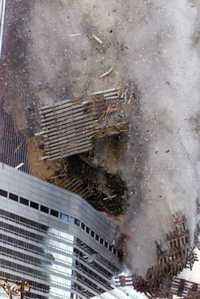 |
| 10:30 | Faced with a report of another hijacked plane coming in fast, Cheney for the third time orders the military to shoot down any incoming aircraft. The incoming target is later determined to be a Medevac helicopter. It is not shot down. |
| 10:30 | Deciding to take a break from rescuing people in a burning building, Donald Rumsfeld begins to acquaint himself with what exactly the hell has been going on in this country. |
| 10:31 | Nearly half an hour after the last hijacked airplane has crashed, NORAD is finally informed that it has authorization to shoot down hijacked airplanes. An internal NORAD text message reads: "Vice president has cleared to us to intercept tracks of interest and shoot them down if they do not respond." Most NORAD operators are confused by the message, so it is never actually sent to the pilots of the fighters in Washington D.C. and New York City airspace. |
| 10:32 | Media reports a car bomb exploding at the State Department, but these reports are wrong. |
| 10:33 | Two hours and 20 minutes since the first hijacking began, the federal government has failed to execute a single action that in any measurable way prevented or contained any aspect of the biggest terrorist attack in the history of America. |
| 10:34 | A second chance to go back in time and do something, ANYTHING, to prevent or contain the attack fails to materialize. |
That's 'President' Cheney To You...
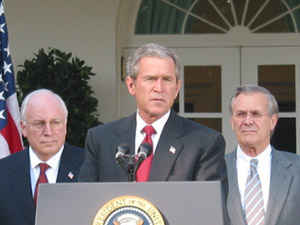 As we have seen, the shoot-to-kill orders were given to the military by the Vice President.
As we have seen, the shoot-to-kill orders were given to the military by the Vice President.
It is perhaps worth noting at this point the mere technicality that the vice president has no statutory power to give orders during a moment of crisis in which the president is NOT incapacitated.
Technically, Bush was not incapacitated at this moment, except perhaps for being rendered insensate by his overwhelming desire to get back to Washington and face danger like a man. Technically, the next person after Bush who is authorized to give the "shoot to kill" order, is Donald Rumsfeld and not Dick Cheney. The President cannot delegate his commander-in-chief authority outside the chain of command. That's why they have a chain in the first place.
Though tempting, it's hard to fault Cheney in this situation. Frankly, if you yourself happened to be walking through the White House bunker on that day, and someone ran up to you and asked "should we shoot down a hijacked aircraft headed right for us," you would have felt justified in saying "shoot first and ask about the appropriate constitutional delegation of authority later."
The more pertinent question is: Why wasn't the President running things?
There are military bases in Florida with everything Bush could have needed to take charge of the situation, while a more secure facility was prepared. And there were multiple facilities suitable for housing the president in this sort of crisis.
Instead, as the entries above and below illustrate, Bush was content to let Cheney call the shots—literally—on what was indisputably the most important day of his presidency.
| 10:38 | Fighters from the 113th Wing of the DC Air National Guard launch from Andrews Air Force Base, on a tip from the Secret Service. |
| 10:39 | When both men are in the "Air Threat" teleconference, Cheney tells Rumsfeld that while Rumsfeld has been rescuing people, Cheney has been ordering planes to be shot down. |
| 10:45 | A Secret Service agent, claiming to relay instructions from the Vice President, tells the commander of the 113th Wing fighters they are "to protect the White House and take out any aircraft that threatens the Capitol." This order is well outside the chain of command, since (as noted) neither the Vice President nor the Secret Service have any legal authority to give orders to the military. |
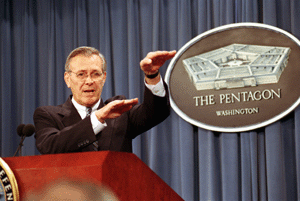
CHENEY: There's been at least three instances here where we've had reports of aircraft approaching Washingtona couple were confirmed hijack. And, pursuant to the President's instructions I gave authorization for them to be taken out. Hello?
RUMSFELD: Yes, I understand. Who did you give that direction to?
CHENEY: It was passed from here through the operations center at the White House, from the (shelter).
RUMSFELD: OK, let me ask the question here. Has that directive been transmitted to the aircraft?
CHENEY: Yes, it has.
RUMSFELD: So we've got a couple of aircraft up there that have those instructions at the present time?
CHENEY: That is correct. And it's my understanding they've already taken a couple of aircraft out.
RUMSFELD: We can't confirm that. We're told that one aircraft is down but we do not have a pilot report that they did it.
As far as anyone credibly knows, no one actually "took a couple of aircraft out." Also, as previously noted, none of the pilots had been informed of their shootdown authorization.
Why Even Have An Air Force One?
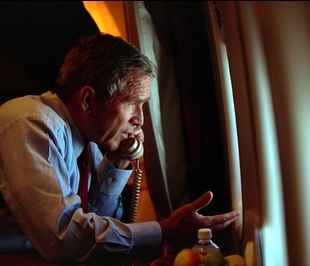 It's worth breaking out of our chronology for a moment here to consider Air Force One, in which the president of the United States is currently sitting. The entire point of mythologizing Air Force One is the idea that the President can—in theory—run the country from anywhere his plane can go. Air Force One is fitted with secure phone lines, secure data lines, radios, televisions, even a fax machine. It has 85 phone lines and requires three operators to run it. It has a fully equipped presidential office, and on September 11, it had a full staff of presidential aides. In short, there was no reason that the President, sitting on Air Force One, couldn't be running the country and very effectively. The airplane was 90% functional while flying, and 100% functional had it simply landed at the nearest military base.
It's worth breaking out of our chronology for a moment here to consider Air Force One, in which the president of the United States is currently sitting. The entire point of mythologizing Air Force One is the idea that the President can—in theory—run the country from anywhere his plane can go. Air Force One is fitted with secure phone lines, secure data lines, radios, televisions, even a fax machine. It has 85 phone lines and requires three operators to run it. It has a fully equipped presidential office, and on September 11, it had a full staff of presidential aides. In short, there was no reason that the President, sitting on Air Force One, couldn't be running the country and very effectively. The airplane was 90% functional while flying, and 100% functional had it simply landed at the nearest military base.
The presidential jet was an easy flight from at least three different facilities designed exactly for this sort of national emergency, including NORAD's underground Operations Center, FEMA's Mount Weather Emergency Operations Center in Virginia, and "Site R," a supersecret military command post near the Maryland border (described in detail by James Bamford in "A Pretext for War"). Every one of these facilities was just as effective as the White House bunker for running a war. Every one of these facilities was effectively immune to bomb and kamikaze jet attacks.
But while the Vice President was issuing extra-constitutional orders that made Alexander Haig look like a rank amateur, the President was nowhere to be found. To explore the reason for this, we must add the following entry to our chronology but qualify it extensively:
| 10:32 | A threat is reported against Air Force One, leading the Secret Service to insist the president not return to Washington, D.C.
|
On September 12, the claim was first made by presidential spokesman Ari Fleischer. "We have specific and credible information that the White House and Air Force One were also intended targets of these attacks."
Specific and credible? The Washington Post gave the following colorful account of the threat in a January 2002 article:
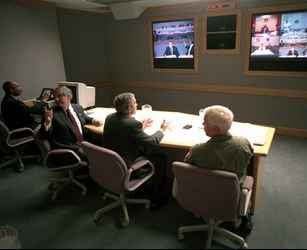
Cheney called Bush on Air Force One, on its way from Florida to Washington, to say the White House had just received a threat against the plane. The caller had used its code word, "Angel," suggesting terrorists had inside information. Card was told it would take between 40 minutes and 90 minutes to get a protective fighter escort up to Air Force One.
Bush told an aide that Air Force One "is next." He was in an angry mood. "We're going to find out who did this," he said to Cheney, "and we're going to kick their asses."
Air Force One was still en route to Washington when Cheney called again at 10:41 a.m. This time, he urged Bush not to return. "There's still a threat to Washington," the vice president said. Rice agreed, and had told the president the same thing.
There was little debate or discussion. Cheney was worried the terrorists might be trying to decapitate the government, to kill its leaders. Bush agreed.
Within minutes, those on board the president's plane could feel it bank suddenly and sharply to the left, its course now westerly toward Barksdale Air Force Base in Louisiana. It was within easy range, and once there food and fuel could be loaded and the president could have access to its more sophisticated communications systems.
The threat to the plane turned out to be false. Someone inside the White House had heard a threat to Air Force One, perhaps in a phoned-in call, and passed it up the line using the code word "Angel." Others thought the threatening caller had used the code word. It took days for the incident to be sorted out and weeks before the White House publicly acknowledged it.
Not only was the threat spurious, but there have been serious questions about whether the exchange described above even took place, whether Cheney might have made up the threat, or whether it was simply a hastily constructed explanation for why the president was running like a scared rabbit.
Whatever the rationale, Bush was not coming back to Washington for several hours.
The Aftermath
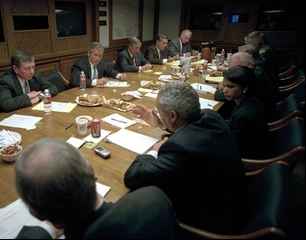 The attack was over, and America was exhausted. While millions sat glued to the television set, awaiting news of the next disaster, the federal government began implementing measures to protect government institutions and civilian structures. Orders were given to evacuate tall buildings around the country, while the executive branch eventually (and ungraciously) got around to providing some protection for the legislative branch.
The attack was over, and America was exhausted. While millions sat glued to the television set, awaiting news of the next disaster, the federal government began implementing measures to protect government institutions and civilian structures. Orders were given to evacuate tall buildings around the country, while the executive branch eventually (and ungraciously) got around to providing some protection for the legislative branch.
The President spent these hours contemplating the attack. By his own account, his first reaction was a desire to get even, and just as soon as he dared set foot back in Washington, he would, by God! The nation went into lockdown, as the false alarms continued to trickle in, and shellshocked Americans would eventually fall asleep with the TV on. And that TV is still on today...
| 10:45 | All federal buildings in Washington, D.C., are evacuated. |
| 11:02 | New York Mayor Rudy Guiliani urges citizens to stay calm and in their homes, except for those living south of Canal St., who are politely urged to run like hell. |
| 11:45 | Air Force One arrives in Barksdale, LA. Soldiers surround the plane. Not that we're scared or anything. Reporters on the plane are banned from disclosing the president's location. |
| Noon | Bush tells Cheney "I think it's important for the people to see the government is functioning, because the TV shows our nation has been blasted and bombed. Government is not chaotic. It's functioning smoothly." Apparently, running a Cabinet meeting from a secret air base in Louisiana in smooth functioning. |
| 12:05 | An extremely nervous-looking Bush tapes a short statement for the nation. "Make no mistake: The United States will hunt down and punish those responsible for these cowardly acts." As the Washington Post observed, "It was not a reassuring picture." |
| 12:05 | George Tenet passes a note to Donald Rumsfeld outlining the NSA's al Qaeda intercept which indicated more targets were expected to be hit. The intercept is more than two hours and 10 minutes old, and the attacks of which it warns have been finished for just over two hours. |
| 12:15 | The INS closes the country's land borders. |
| 12:16 | All commercial aircraft in United States airspace are on the ground. The entire country is effectively in a lockdown. |
| 1:04 | Taped Bush statement airs. Country is not reassured. |
| 1:27 | Washington, D.C., belatedly declares a state of emergency. |
| 1:44 | Pentagon announces that five warships and two aircraft carriers are being dispatched to protect the East Coast. |
| 1:48 | Air Force One takes off again, after ditching most of the press corps. A few reporters are allowed to remain on the plane, sans cell phones. |
| 1:47 | Ari Fleischer tells the remaining press "The President is looking forward to returning to Washington. He understands at a time like this, caution must be taken; and he wants to get to back to Washington." |
| 2:36 | Bush calls his dad, who is in Milwaukee. According to the Washington Post, Bush asked his father: "What are you doing in Milwaukee?" The response: "You grounded my plane." |
| 2:49 | Guiliani announces the restoration of limited bus and subway service in New York. |
| 2:50 | Bush lands in Offut Air Force Base in Nebraska, the nerve center of the Western World. |
| ~3:15 | An aircraft is tracking toward the U.S. from Spain giving off an emergency signal. It's a false alarm. |
| 3:30 | Bush chairs a meeting of the National Security Council via teleconference. During the meeting, Bush announces that the airline industry will resume flights at noon on September 12. |
| 3:55 | Presidential spokeswoman Karen Hughes announces: "While some federal buildings have been evacuated for security reasons and to protect our workers, your federal government continues to function effectively." |
| 4:10 | Building 7 of the World Trade Center complex is reported to be on fire. The building housed, among other things, a secret CIA command center. |
| 4:25 | U.S. stock markets announce there's no way in hell they are going to be able to open on September 12. |
| 5:20 | Building 7 of the WTC complex collapses. Later, the building's destruction becomes the subject of conspiracy theories. |
| 5:30 | Fleischer emerges again. "Information is provided to the President about any type of threat, and the President makes the final determination. The President wanted to get back to Washington. He understood that there can be a period of caution so that the security people can make a full and proper assessment about any threats." |
| 6:00 | The Northern Alliance just happens to attack the Taliban in Afghanistan. |
| 6:34 | Air Force One lands at Andrews Air Force Base. Bush transfers to a helicopter to travel the remaining miles to the White House, detouring to survey the damage at the Pentagon. |
| 6:40 | Rumsfeld announces the Pentagon will open for business on Sept. 12. |
| 6:54 | Bush returns to the White House. |
| 7:17 | FBI solicits tips from the public on the attacks. |
| 8:30 | Bush addresses the country for seven minutes. He articulates the fateful Bush Doctrine for the very first (but far from the last) time:
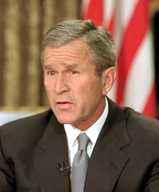
Immediately following the first attack, I implemented our government's emergency response plans. Our military is powerful, and it's prepared. Our emergency teams are working in New York City and Washington, D.C. to help with local rescue efforts.
Our first priority is to get help to those who have been injured, and to take every precaution to protect our citizens at home and around the world from further attacks.
The functions of our government continue without interruption. Federal agencies in Washington which had to be evacuated today are reopening for essential personnel tonight, and will be open for business tomorrow. Our financial institutions remain strong, and the American economy will be open for business, as well.
The search is underway for those who are behind these evil acts. I've directed the full resources of our intelligence and law enforcement communities to find those responsible and to bring them to justice. We will make no distinction between the terrorists who committed these acts and those who harbor them.
|
| 9:00 | Bush meets with his National Security Council. |
| 11:08 | Awakened from sleep, George and Laura Bush rushed to underground bunker beneath the White House, after a report of an unidentified plane in the area. It was a false alarm. |
| 11:59 | "Good night, George." "Good night, Laura. I sure hope tomorrow goes better than today did." "Me too, George. Me too." |
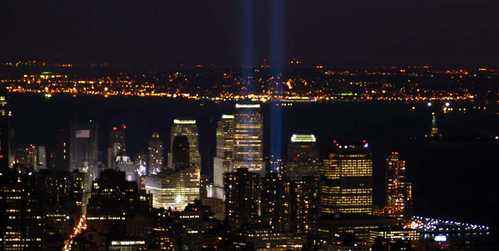
Pornopolis |
Rotten |
Faces of Death |
Famous Nudes
|
 When you look at the minute-by-minute account of what happened on September 11, a few things become clear.
When you look at the minute-by-minute account of what happened on September 11, a few things become clear. During the first phase of the attack, it took a few minutes to figure out what was happening. That isn't surprising. But while air traffic controllers on the front lines quickly figured out the significance of what they were hearing, the FAA and other managers failed to treat this information with the urgency and speed it demanded.
During the first phase of the attack, it took a few minutes to figure out what was happening. That isn't surprising. But while air traffic controllers on the front lines quickly figured out the significance of what they were hearing, the FAA and other managers failed to treat this information with the urgency and speed it demanded.  As we have seen, the shoot-to-kill orders were given to the military by the Vice President.
As we have seen, the shoot-to-kill orders were given to the military by the Vice President.

 It's worth breaking out of our chronology for a moment here to consider Air Force One, in which the president of the United States is currently sitting. The entire point of mythologizing Air Force One is the idea that the President can—in theory—run the country from anywhere his plane can go. Air Force One is fitted with secure phone lines, secure data lines, radios, televisions, even a fax machine. It has 85 phone lines and requires three operators to run it. It has a fully equipped presidential office, and on September 11, it had a full staff of presidential aides. In short, there was no reason that the President, sitting on Air Force One, couldn't be running the country and very effectively. The airplane was 90% functional while flying, and 100% functional had it simply landed at the nearest military base.
It's worth breaking out of our chronology for a moment here to consider Air Force One, in which the president of the United States is currently sitting. The entire point of mythologizing Air Force One is the idea that the President can—in theory—run the country from anywhere his plane can go. Air Force One is fitted with secure phone lines, secure data lines, radios, televisions, even a fax machine. It has 85 phone lines and requires three operators to run it. It has a fully equipped presidential office, and on September 11, it had a full staff of presidential aides. In short, there was no reason that the President, sitting on Air Force One, couldn't be running the country and very effectively. The airplane was 90% functional while flying, and 100% functional had it simply landed at the nearest military base.
 The attack was over, and America was exhausted. While millions sat glued to the television set, awaiting news of the next disaster, the federal government began implementing measures to protect government institutions and civilian structures. Orders were given to evacuate tall buildings around the country, while the executive branch eventually (and ungraciously) got around to providing some protection for the legislative branch.
The attack was over, and America was exhausted. While millions sat glued to the television set, awaiting news of the next disaster, the federal government began implementing measures to protect government institutions and civilian structures. Orders were given to evacuate tall buildings around the country, while the executive branch eventually (and ungraciously) got around to providing some protection for the legislative branch. 













